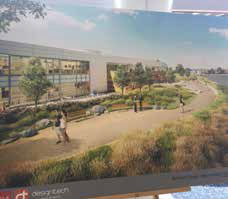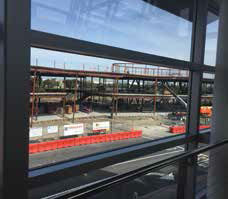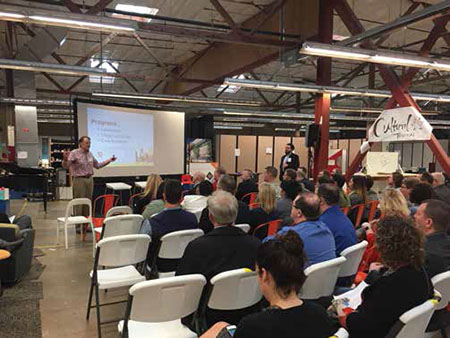MARCH 2017 SCHOOLCIO SUMMIT REFLECTION
“Don’t think outside the box. Think without a box.” That quote by opening panelist Chris Budzynski (@chrisbudzynski) really summed up much of what was discovered and discussed at the recent School CIO summit hosted by Tech & Learning magazine (@techlearning). These summits provide excellent opportunities to connect with other leaders across the country as well as provide resources and tools to help districts continue to lead and innovate. This post is a reflection of some of the things I discovered and a couple of wishful thoughts on things I hope we get to do in my district.
DESIGN TECH HIGH SCHOOL VISIT

Imagine if you found an abandoned warehouse and threw a bunch of tools, whiteboards, technology, and high school kids in it. What do you think might happen? The “DTech” high school is just that. Students don’t have a bell schedule or a series of classes to sit through. Instead, they are working on design projects that incorporate the core content areas as well as some serious soft skills that they’ll need in the future.

“Principal” Ken Montgomery took us through a tour of his facility and their day-today schedule. I put the word principal in quotes, because he’s really part principal, part passion-driven student advocate, and part crazy (in a good way). This school is based somewhat on the Stanford DSchool concept and has been built out of a partnership with local tech giant Oracle and its Education Foundation.

Although classes were over for the day when we walked up, I noticed quite a few students hanging out on a Friday, not ready to leave. What does that say about the school when kids are running to the weekend? I stopped to ask one of the students what they thought about the place and concept. He replied, “I love it.” When I asked him why he said, “The people. They love it here and they care about us and our learning. It shows.”
I think that quote could be shared about any great teacher, but it was clear that for this young man, the school provided him with an opportunity that he might not have received in a more traditional setting. The few students still milling about inside the building/warehouse were finishing a robotics project or studying Mandarin just….because. Next year, the students of DTech will move into a brand new innovative building on Oracle’s campus, but I really loved the messy feeling of this old warehouse. The imperfections and griminess left me with the impression that this building (and program) are very much loved.
OPENING PANEL ON BLENDED LEARNING
The following day, we were treated to an opening panel that featured three school leaders from very different places. Emily Garrison (@ emilyagarrison) from Palo Alto Unified School District was up first. Her school district is considered a “sister” school district of Eanes ISD, so I was curious to hear her thoughts on how to make things more blended for students. Their program began with one teacher several years ago and was built on the iNACOL framework for blended learning. While there were various models presented, from in-house to twilight (after-hours), the program’s growth and success was largely due to the focus on mindset and strong professional learning for staff. Their mantra for the program of “Time, place, path, and pace” helps guide students towards different opportunities for learning success.
Next up was Chris Budzynski, who I mentioned in the opening paragraph. Chris’s district, just outside of Chicago, has also purposefully grown a blended learning model where students have multiple periods a day to learn in a blended setting (usually first or last period). Additionally, with the opening of a new hospital near their high school, they partnered with the doctors in providing the first of its kind high school hospital internship program. A group of students spend part of their school day shadowing and helping staff in the hospital while still taking a full course load—an incredible opportunity to any young person thinking of working for the medical industry.
The final panelist was Bryant Wong from Summit Public Schools. Summit is a blended charter that has over 100 schools all over the country and is focused on both diversity and success after college. Its format provides a playlist of learning options for each student, creating a personalized approach for its learners. With help from Khan Academy and Facebook, Summit has been able to freely provide opportunities to kids that might not exist where they live. While I’m a fierce advocate for public schools, this charter seems to have its heart in the right place.
WORKING GROUPS

Besides site visits and hearing from innovative leaders in the K-12 space, the summit also provides time throughout the day to share best practices in working group meetings. I presented some of the ways we have tried to educate both parents and students on digital citizenship. In talking with the others in the group, Common Sense Media continues to be a national leader on the subject through their freely provided content.
For the second working group on learning spaces, I got to play the role of learner. One of the main presenters was Michael Morrison (@ mytakeontech) from Laguna Beach USD. He shared their “4CLE” project that focused on furniture, lighting, and color as part of a positive student learning environment. One thing that really stuck with me, besides the super-cool use of Hue bulbs to change classroom color digitally, was that they used a lot of flat screen TVs in their rooms. Many of the rooms had two or more TVs that Michael mentioned could cost around $150 (for a 32-inch screen)—an interesting idea and a break from the single expensive projector at the front of the room approach that we usually take in classrooms. The TVs all connect via a hub and teachers or students can project their work on the screens.
TAKE-AWAYS
It’s clear to me that there is a lot of good happening in education around the country, despite what some news articles may say. These school leaders shared many valuable resources and research in their efforts to help each student along their own personal learning journey. For me, I want to take back the idea of really examining our school schedule and the limitations it might be having on learning for some students. I know many of our kids excel at playing the “game of school” but for some, as witnessed by early success of our WHS Incubator class, there isn’t a one-size-fits-all approach when it comes to student learning. Giving more of our students agency in their learning needs to continue to be a focus of ours as we travel into the second iteration of our 1:1 mobile device program and flexible furniture pilots.
Carl Hooker is the Director of Innovation and Digital Learning, Eanes I.S.D., the founder of “iPadpalooza,” and author of the Mobile Mindset series. Read more at Hooked on Innovation (hookedoninnovation.com).
Tools and ideas to transform education. Sign up below.
Carl Hooker has spent the past 20+ years in education as a teacher and administrator focused on the thoughtful integration of technology and innovation. He consults for multiple districts across the country and is a frequent speaker at state and national events. In his free time he's an author, DJ, podcast host, Poetry Slammer, and Trivia Night MC. He's the co-founder of the social platform K12Leaders.com. Check out his latest book Ready Set FAIL! Now available for order here: https://mrhook.it/fail Read more of his blogs at Hooked on Innovation.
